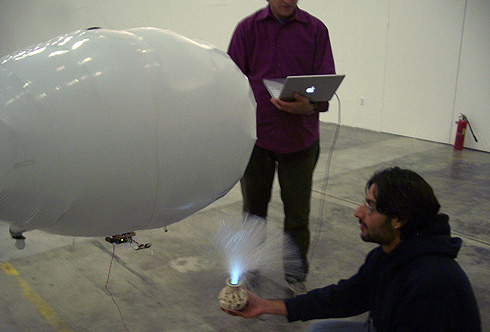TECHNOLOGY
1.1 SUNSPOTS
How could we design something in an uncertain fluid environment with unknown outcomes? This was possible through the sponsorship of Sun Microsystems who donated instrumental technology (SunSpot system powered by Java). We used nature as an inspiration model to explore in depth the engineering of SunSpots and realized how the SunSpot can serve as a hub for a variety of external systems. We used design research to test the capabilities of the technology to fit into our framework.

1.2 CIRCUITS
Our circuits included the following: auxiliary 3V lithium battery, 5 integrated circuits and motors, and 2N7000 transistors with 1M ohm resistors. Due to maneuverability efficiency (for example hovering) we used five independent motors to cover all directions. Eventually the SunSpot was incorporated with the motors and circuits to serve as a hub to control external components. The construction and circuits were refined to streamline weight, power, and efficiency.

1.3 SOFTWARE
We created a Java application designed to test and visualize the prototype’s navigation capabilities using long-range radio communication to travel towards a specific location. Next we created a vehicle controller application. We used the laptop as a platform for controlling the ALAV’s on board motors. It was designed to log our data so we could refine our final navigation algorithm. This was the most appropriate way to test the unpredictability of the ALAV’s real world behavior.

1.4 BLIMP & EXTERNAL COMPONENTS
As a starting point, we hacked into existing RC blimp technology which included extensive buoyancy testing. For precision, we designed a laser cut balsa wood carriage suspended from the helium-filled envelope carriage to house the hardware. By using Rapid Prototyping techniques, we took as much handwork out of the process after we realized that even a minor variation in weight distribution can have significant ramifications on the performance of the ALAVs. After the model was complete, we started to build the necessary components to complete our scenarios: food, LEDs, and cellphone vibrator on the envelope. The vibrator resonates quickly through the helium envelope and results in a whaling call. The complete functioning system required fine-tuning the integration of the hardware and software.

1.5 ADDITIONAL PROCESS PHOTOS & DOCUMENTATION
|
|---|
All materials contained therein are © copyright 2005-2006, Jed Berk + Nikhil Mitter